Maintaining a beautiful lawn requires time, discipline, and a few specialized tools. To make your lawn healthy and beautiful, you may find it helpful to explore lawn care and the necessary equipment to maintain your yard. When used correctly, efficient lawn equipment like a lawn mower and aerator make your life easier and your lawn healthier. This equipment, combined with proper lawn care practices, ensures a healthy, aesthetically-pleasing lawn.
Essential Equipment for Lawn Care
There are many lawn equipment options in today’s lawn care market. It is difficult to know where to start and what to look for in each tool. Understanding each tool’s purpose and effect on your lawn can help you make the right equipment choices.
Shop All of Our Lawn & Garden Tools
Lawn Mower
The different lawn mower models are categorized by how they cut grass and their power source. There are rotary mowers and reel mowers. Rotary mowers are more common and use high-speed rotating blades to cut grass. Reel mowers use rotating blades to cut grass against a stationary bedknife. Rotary mowers are usually powered by gas or electricity, while reel mowers are user-powered. Opt for a push reel mower to keep your lawn looking tidy without the pollution and noise associated with the typical lawn mower. A push reel mower also gives you a good workout; however, push reel mowers do not work well with tough grass like crabgrass.
Electronic rotary mowers are the most popular option on the market. Their popularity arises due to their lack of fumes from gas and oil. They also boast a reduced operating volume. Additionally, these mowers use cords or rechargeable lithium-ion batteries as a power source, allowing you to mow for extended periods without recharging.
The most common type of lawn mower is a gas-powered mower. Gas mowers come in push or ride-on varieties. They also contain helpful features like dethatcher attachments. There are front-wheel drive mowers that make the machine much easier to maneuver. If you want to use your grass clippings as mulch, use a mower with mulching and bagging options.
Your lawn type and noise level preferences affect the kind of lawn mower you choose to use. The bigger your yard, the larger mowing diameter your mower should have. For example, a 30 to 39 cm mowing width mower is suitable for a yard 250 square yards or less. A 2,000 square foot yard lawn requires a lawn mower with a 50 to 54 cm self-propelled mower because it saves user energy.
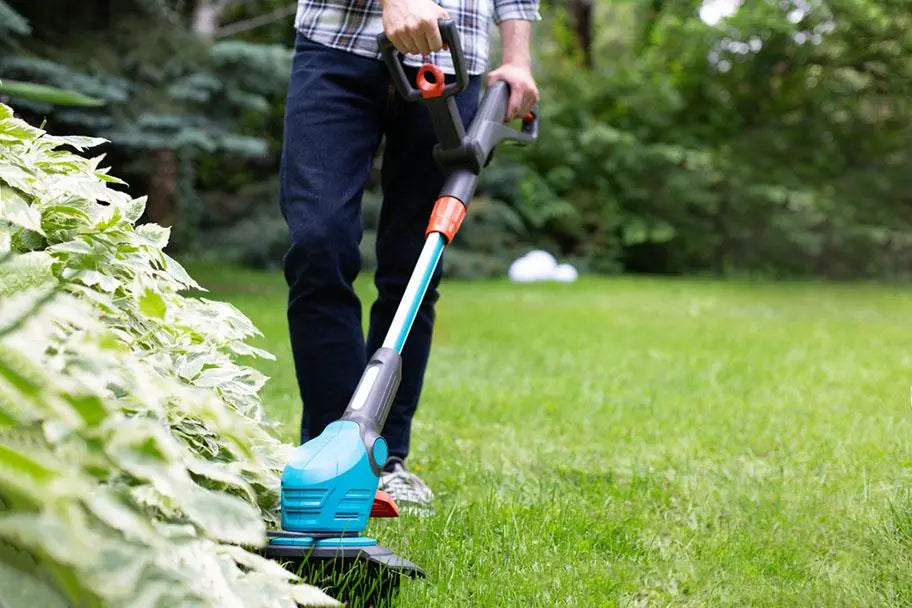
Edger
An edger uses a metal blade to cut grass where it is adjacent to a non-grass surface like a rose garden, sidewalk, or pathway, creating a clean edge for your lawn. There are manually powered edgers available, but electric edgers are standard because they are easy to use and precise.
The DeWalt 60V Max 7.5" Edger Kit has a hardened steel blade to create a clean edge no matter how tough your lawn’s overgrowth. The 7.5" blade also has 2.5" of vertical adjustment depth. The adjustable blade combined with the large guide wheel gives this lawn tool ease of movement and great accuracy.
String Trimmer
String trimmers use rotating nylon string to cut grass that the lawn mower cannot access. Inaccessible points may include around large potted plants or against a fence. It may also include space near large amounts of debris where using a mower is unsafe. Without a string trimmer, you risk a splotchy lawn because your mower cannot reach specific patches of grass.
There are gas-powered string trimmers, but most are electric-powered because string trimmers are usually not needed for longer than a battery’s charge. Some string trimmers can double as an edger by rotating their strings to cut vertically. Like the edger, a good string trimmer is lightweight and ergonomic because its application requires precision. The Husqvarna 520iLX Battery-Powered String Trimmer is exceptionally light, weighing only 6.6 lbs. without the battery. It also has reversible string rotation to keep grass clippings from making a mess on a sidewalk, and the 180° handle lets users angle the string for edging and trimming all in one.

Lawn Spreader
A lawn spreader is a manually powered tool that uniformly spreads fertilizer, seeds, or pesticides on a lawn. There are handheld spreaders, broadcast spreaders, and drop spreaders. The one you select depends on the size of your lawn and your landscape design. Opt for a broadcast spreader if you have a large lawn with few landscaping elements. Broadcast spreaders disperse material in a wide, overlapping pattern and cover large yards quickly.
If your yard features complex landscaping elements, a drop spreader is better. It sacrifices efficiency for accuracy. Instead of broadcasting the material, a drop spreader drops material directly below it. A handheld spreader is suitable for small lawns or lawns with complex landscaping.
Leaf Blower
Leaf blowers are helpful when you need to clear mower clippings and leaves out from your lawn quickly and efficiently. When leaves and mulch build up on your lawn, they can block moisture and air from reaching the soil. Too much mulch is detrimental to a lawn’s health and longevity.
In the past, the issue with leaf blowers was their high noise level. The Husqvarna Battery Blower solves this problem by only reaching 60 dB, the same level as normal conversation. It is well-balanced and only weighs 5.29 lbs., making it easily operable for almost any user. Its efficient and powerful brushless engine combines high-capacity batteries for long-lasting power.
Dethatcher
Thatch is a layer of organic material right above the soil that can be detrimental to lawn health. Thatch is composed of dead and living materials like old mower clippings, roots, and other organic materials. Thatch blocks moisture, air, and sunlight from getting to the soil when it gets too thick, preventing grass and vegetation growth. A dethatcher breaks up thatch to reinvigorate your lawn.
Only use a dethatcher when the thatch is thick enough to block moisture and sunlight from reaching the soil. It takes soil about a month to recover from dethatching. Some people leave dethatching to lawn servicers because it is such an infrequently used tool; however, you can remove thatch on your own and restore health to your yard with the right piece of equipment,
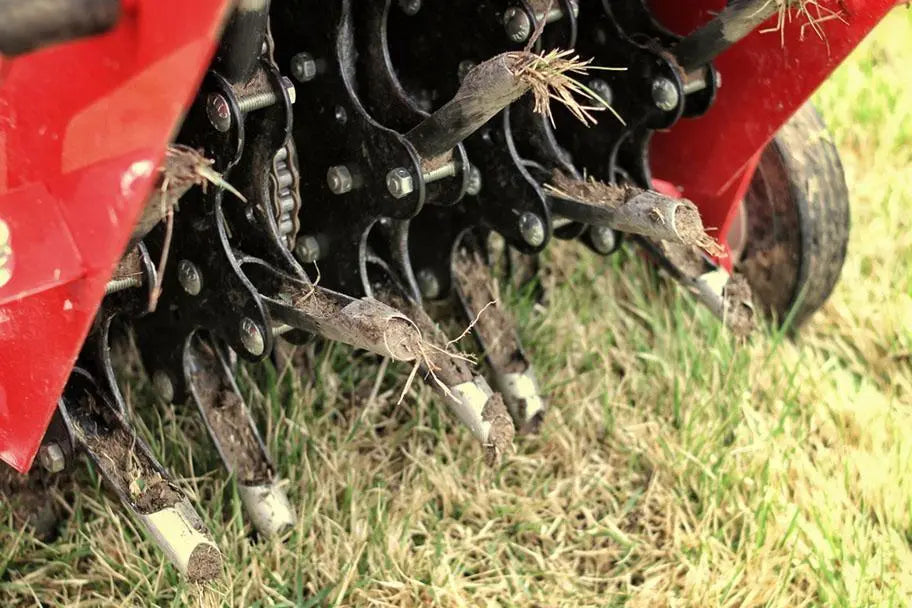
Aerator
An aerator removes small sections of turf and soil to allow air, nutrients, and water back into the soil. Aerating your lawn at least once every two years helps keep the soil light and airy, encouraging lush lawn growth. Heavily compacted lawns, or those that see frequent foot traffic, benefit from yearly aeration in the fall.
Rakes
Rakes help with cleaning up, dethatching, and aerating lawns. A leaf rake is a lightweight rake that collects loose debris while leaving the grass intact and undisturbed. A garden or soil rake is weightier and features pointed prongs that dig into the soil. These elements are used for dethatching and breaking up the soil before reseeding.
Lawn Care 101
Armed with the right tools, all you need is the right lawn care maintenance program to create a beautiful lawn free of weeds and pests. A good lawn care program starts as the ground thaws and continues through summer into fall to maintain a perfect lawn year after year.
Weeding the Lawn
Removing weeds in the spring ensures your lawn stays weed-free all summer because the weeds do not get a chance to spread their seeds. You can remove large weeds by hand, but make sure you remove the whole root or it will grow back. Handheld weeders, weeding knives, and trowels help remove the entire weed and root system without disturbing the soil.
If your lawn has a lot of weeds that are hard to remove, you can spray them with herbicide manually. Weed and feed products combine herbicide to remove weeds and fertilizer to enhance grass growth. Use a broadcast lawn spreader to efficiently spread weed and seed or a handheld spreader to distribute herbicide accurately.
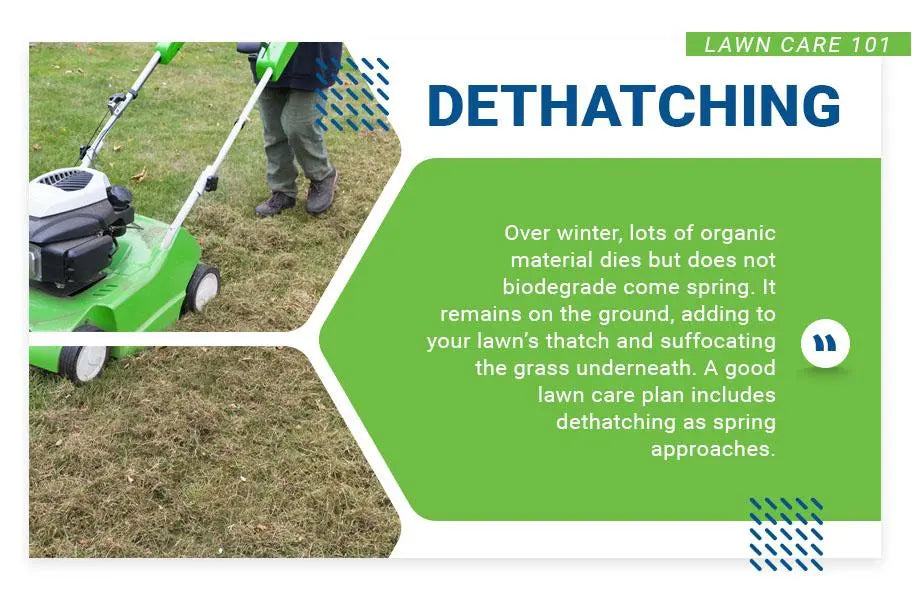
Dethatching
Over winter, lots of organic material dies but does not biodegrade come spring. Instead, it remains on the ground, adding to your lawn’s thatch and suffocating the grass underneath. A good lawn care plan includes dethatching as the spring season approaches.
The best time to dethatch your lawn is when the grass is growing and the soil is moist. This allows your lawn to bounce back healthier and quicker because the wet soil breaks down nutrients for the roots to absorb. You can dethatch cold climate grasses like Kentucky bluegrass in early spring or early fall. For warm-climate grasses like Bermuda grass, dethatch in the late spring or early summer. You should aerate at the same time you dethatch your lawn.
Aeration
Aeration is necessary when your lawn’s roots are not growing deeper than 2". To check the depth of your lawn’s roots, dig out a cubic foot of lawn and inspect the roots. If the roots are less than 2" long, you should consider aerating the soil.
If your lawn needs aeration, use an aerator or garden rake to expose your lawn to nutrients, water, and air. If you aerate in the spring, treat the lawn with pre-emergent herbicide because aeration helps all things grow, weeds and grass included. Pre-emergent herbicide creates a chemical layer on the soil to stop weeds from growing in the newly aerated soil.
Reseeding and Overseeding
Reseeding your lawn regrows grass on bare spots and overseeding increases lawn thickness. The best time to reseed a bare patch of lawn is in early fall after you dethatch and aerate the area. Cooler temperatures facilitate grass growth and inhibit weed propagation.
Overseeding does not require breaking up your turf and soil. Instead, use a lawn spreader to disperse a layer of seeds onto thinning grass. In spring, when the temperatures are still a bit chilly, spread cool climate seeds like Kentucky bluegrass. Then, as the temperatures rise, overseed with warm climate seeds like Bermuda grass.
Water your lawn immediately after reseeding and overseeding. Moist soil helps seeds germinate. Just avoid overwatering, as that can wash away your seeds.
Fertilizing the Lawn
Fertilizer gives your lawn the nutrients it needs to grow quickly and densely. Fertilize your lawn once or twice a year with small amounts of fertilizer. Too much fertilizer deposits excess nitrogen in the soil. Over-fertilizing results in water leaching out of the grass back into the soil, leaving your lawn with an undesirable burnt appearance.
Fertilize once in early spring to facilitate initial growth, once in early summer to strengthen the grass for tough summer conditions, and once in fall to rejuvenate the grass after a summer of high temperatures and dry air. Use a lawn spreader to ensure the fertilizer is evenly distributed and does not cause lawn burn.
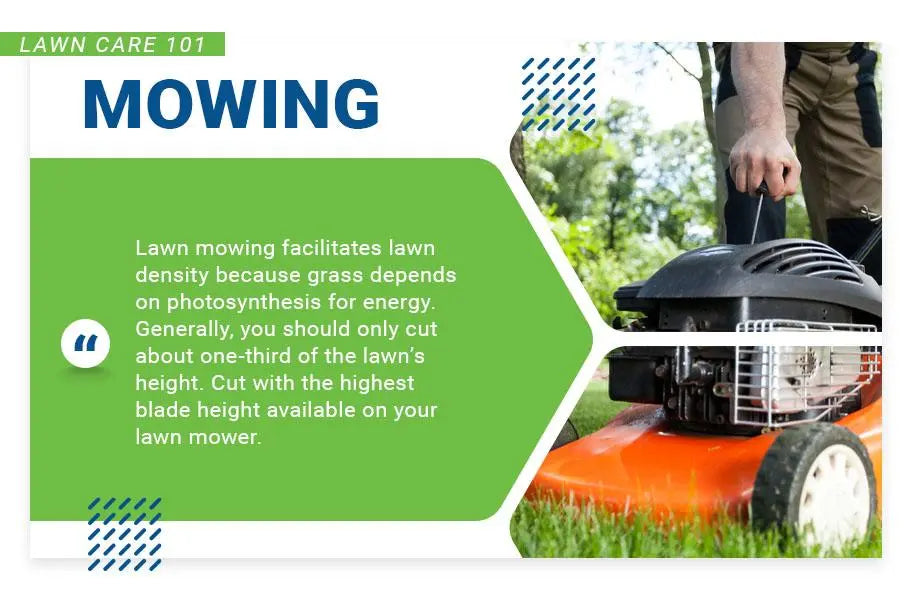
Lawn Mowing
Lawn mowing facilitates lawn density because grass depends on photosynthesis for energy. When it is cut, it needs to regrow. When you remove grass tips regularly, the grass grows laterally instead of vertically. It also increases the amount of sunlight that reaches the soil, which helps new grass grow. Generally, you should only cut about one-third of the lawn’s height. Usually, you should cut with the highest blade height available on your lawn mower.
Mowing with the highest blade setting ensures you do not damage the plant structure or tear up the roots. Only cut the lawn when dry and change mowing direction for each successive mow. You are less likely to compact the turf and soil with the mower tracks when you change mowing directions.
During spring, you should only mow if your lawn has started to grow. In summer, pay attention to your turf’s growth. Grass goes dormant in high temperatures or dry air. If this occurs, avoid mowing for a week or two. Mowing stresses grass by cutting off a portion of its photosynthesizing body. When it is dormant, you risk killing the grass by mowing.
Edge Trimming
Edging your lawn is essential for a crisp appearance. Proper edging is critical for your lawn’s weed defense because doing it wrong creates bare patches of soil where weeds can grow. That is why it is best to use an edger made specifically for edging rather than trying to edge your lawn with a string trimmer.
Combine sharp edges on your lawn with neat hedges with a 20V max lithium-ion DeWalt hedge trimmer. With a 22" blade and lightweight design, this tool cuts hedge branches up to ¾" thick and makes 2800 cutting strokes per minute.
Watering the Lawn
Your lawns’ water needs to change with the seasons. Grass goes dormant in winter and needs no water at all. In spring, grass needs limited watering because spring rains or snowmelt supply the necessary water. However, grass needs about an inch of water a week to continue growing in the summer. The grass starts to go dormant in the fall, so less watering is appropriate.
Always pay attention to the rainfall to avoid accidentally overwatering your lawn. Too much water inhibits oxygen transfer into the roots, killing your grass. Water your lawn during the early morning to reduce the evaporation that comes with direct sun. Watering at night is not recommended, as it can cause mold to grow and attract bugs.
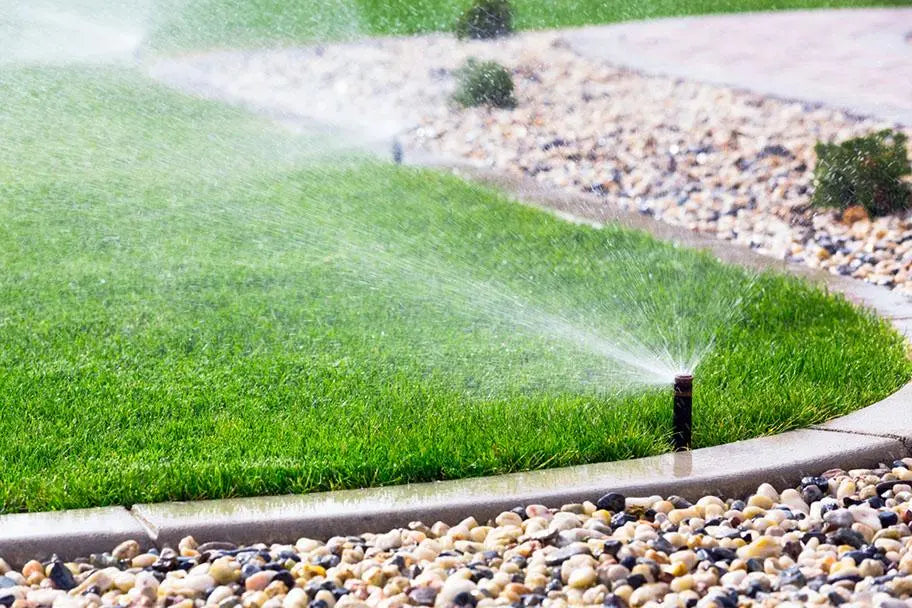
It is better to do one large watering a week than multiple small waterings. A large watering ensures the water soaks into the soil and roots. Short waterings only wet the surface and limit root growth.
Browse Our Electric Edgers
Invest in High-Quality Tools for Your Lawn
Maintaining a beautiful lawn requires commitment and planning. To achieve excellent results, you must keep track of soil nutrients, aeration, thatch levels, weekly watering, and trimming. With the right tools, taking care of your lawn is simple and routine and results in a gorgeous lawn you can enjoy.
At Contractors Direct, we offer professional quality lawn care tools and equipment you need. Whether maintaining your lawn or running a lawn care business, we have the quality and selection to get the job done. View our equipment selection online or contact us to learn more about our lawn care tools and pricing.
Image Credits
The Toidi/Shutterstock.com
Paul Maguire/Shutterstock.com
Photographee.eu/Shutterstock.com
topseller/Shutterstock.com
JacZia/Shutterstock.com
Alan Kidd/Shutterstock.com
topseller/Shutterstock.com

